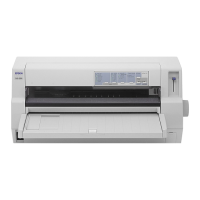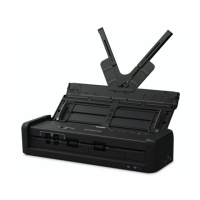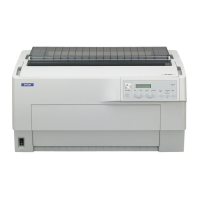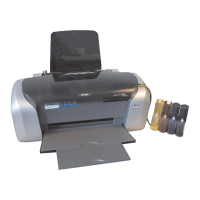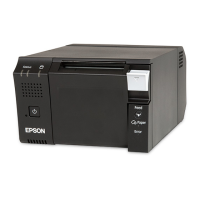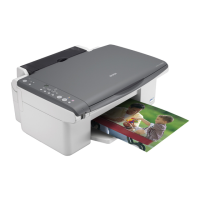How to align vertical lines on Epson DLQ-3500II Printer printout?
- Jjames13Sep 9, 2025
If vertical printed lines are not aligned on your Epson Printer, use the printer’s bidirectional adjustment mode to correct this problem.
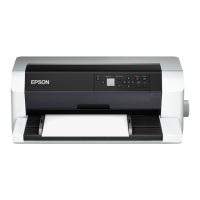
How to align vertical lines on Epson DLQ-3500II Printer printout?
If vertical printed lines are not aligned on your Epson Printer, use the printer’s bidirectional adjustment mode to correct this problem.
Why my Epson DLQ-3500II Printer does not work and the control panel lights are off?
If your Epson Printer doesn't work and the control panel lights are off, there could be several reasons: * The printer might be turned off: Ensure the printer is turned on. * The power cord may not be properly plugged in: Turn off the printer and ensure the power cord is firmly plugged into both the electrical outlet and the printer itself. Then, turn the power switch back on. * The electrical outlet might not be working: Try using a different outlet to rule out a faulty power source.
How to fix Epson DLQ-3500II Printer when the lights on the control panel do not go on?
If the lights on the control panel of your Epson Printer don't turn on, here are a couple of things to check: * Power cord: Make sure the power cord is correctly plugged into the electrical outlet. * Outlet functionality: If the outlet is controlled by a switch or timer, try a different outlet. Test the outlet with another device to ensure it's working properly.
Why does my Epson DLQ-3500II print strange symbols, incorrect fonts, or other inappropriate characters?
If your Epson Printer is printing strange symbols, incorrect fonts, or inappropriate characters, consider the following: * Communication issues: Ensure you are using the correct interface cable and that the communications protocol is correct. * Character table selection: Select the correct character table using your software or the printer settings. Note that the character table setting in your software takes priority. * Printer selection: Make sure the correct printer is selected in your application before printing.
Why is all the text printed on the same line with my Epson DLQ-3500II?
If all the text is printed on the same line when using your Epson Printer, turn on the auto line feed setting in the printer settings. This will automatically add a line feed code to each carriage return.
| Type | Dot Matrix Printer |
|---|---|
| Print Method | Impact Dot Matrix |
| Print Speed | 550 cps (10 cpi) |
| Maximum Resolution | 360 x 360 dpi |
| Input Buffer | 128 KB |
| Noise Level | 55 dB(A) |
| Number of Pins | 24 pins |
| Print Direction | Bidirectional |
| Paper Width | 4 to 16 inches |
| Interface | USB, Parallel, Serial |
| Emulations | IBM PPDS |
| Paper Path | Manual Insertion, Push Tractor, Pull Tractor |
Identifies physical components of the printer, such as cover, edge guide, and paper support.
Details the printer's operation panel, including its layout and primary controls.
Explains the function of each button and indicator light on the printer's control panel.
Provides an overview of menus and controls displayed on the printer's LCD screen.
Describes how to access and configure basic printer settings like Paper Source, Font, Pitch, and Language.
Covers fundamental printer configurations including Paper Source, Font, Pitch, and Language selection.
Details settings related to printer configuration, including print area, character spacing, and print control.
Instructions for printing the current printer configuration settings.
Allows adjustment of margins such as Top of Form, Page Length, and print offsets.
Options for selecting fonts, pitch, and character tables for text appearance.
Options like Auto Tear Off, Print Direction, and Head Gap adjustments.
Configuration options for printer connectivity interfaces like Parallel, USB, and Network.
Settings for network-connected models, including device name, TCP/IP, and link speed.
Guide on choosing the appropriate paper input method, like tractor or sheet guide.
Explains the relationship between paper sources and types for optimal loading and printing.
Adjusts print head height based on paper thickness to ensure print quality.
Overview of essential Epson software, including the printer driver and Status Monitor.
Instructions on accessing and utilizing the printer driver for configuration and printing tasks.
Steps to open the printer driver from an application's print dialog box.
Steps to access the printer driver via the Windows Start menu for system-wide settings.
How to interpret error messages and guidance displayed on the printer's LCD screen.
Explains error codes and guidance displayed on the printer's LCD screen for troubleshooting.
A guide to common printer issues and their corresponding remedies and troubleshooting steps.
Provides links and resources for online support, drivers, FAQs, and manuals.
Information on how to contact Epson support services for assistance with product issues.
Advice on gathering necessary product and system information before contacting support.
Lists the various manuals supplied with the Epson printer for different needs.
Explains conventions, symbols, and terms used throughout the user guide.
Lists the supported operating systems and how they are referenced in the manual.
Comprehensive safety guidelines to ensure safe operation and prevent damage.
Defines the meaning and importance of different safety alert symbols used in the manual.
Information on identifying and avoiding contact with hot printer components.
Crucial safety advice to be followed before operating the printer for the first time.
Safety precautions related to the physical placement and installation of the printer.
Safety guidelines and procedures for cleaning and servicing the printer components.
Safety tips and precautions for loading and managing paper to prevent jams or damage.
Safety advice and precautions for the daily operation and use of the printer's controls.
Limitations on using the product in high-reliability or safety-critical applications.
Safety regulations and advice specific to regions like the UK, Germany, and others.
